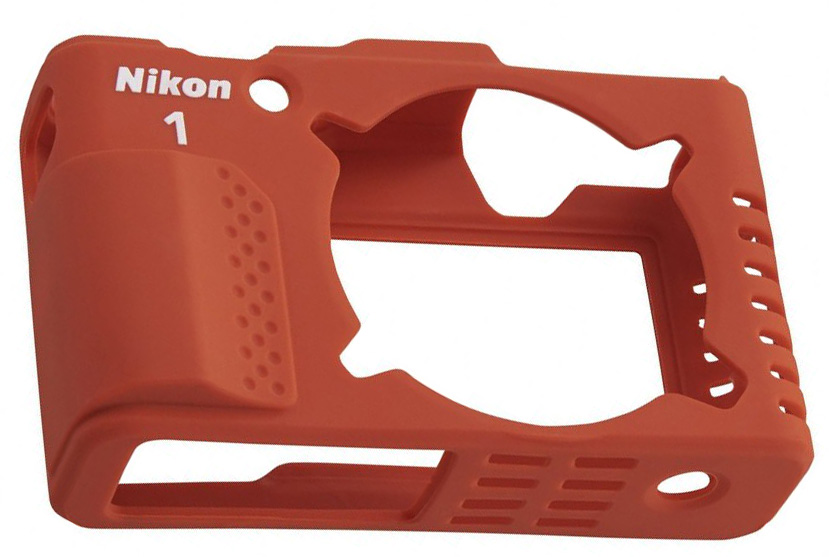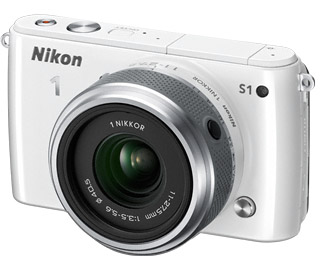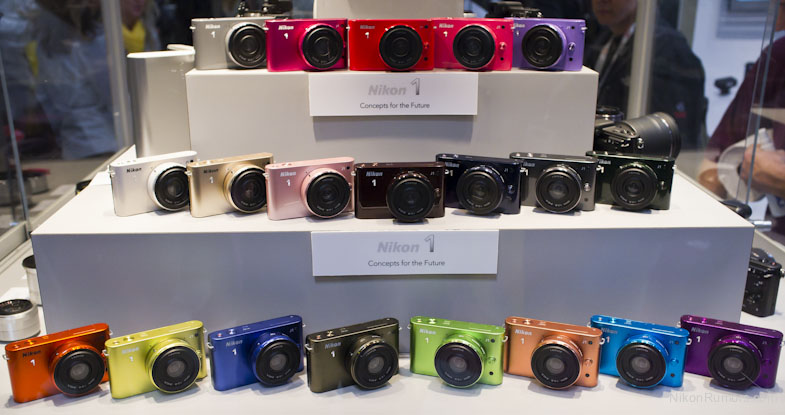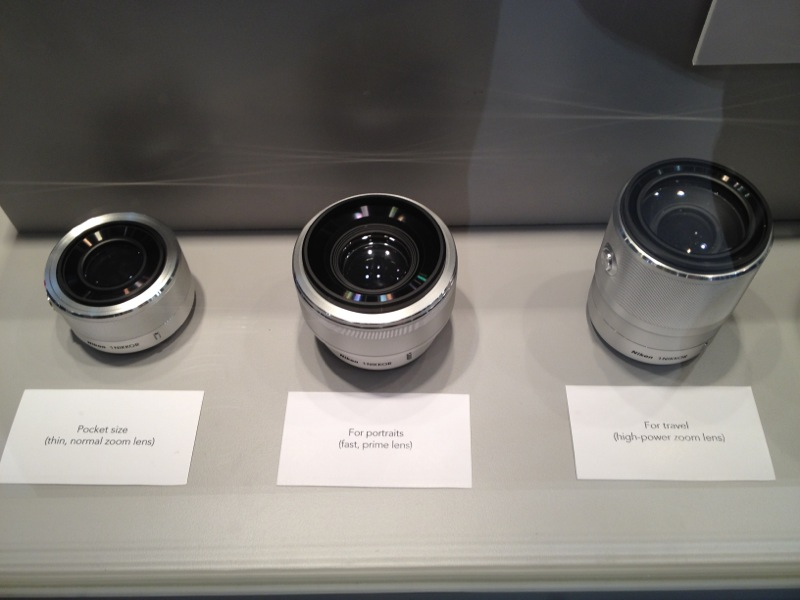Since 1996, Nikon proposes digital cameras for mass-market called Coolpix, followed in 1999 by DSLR cameras, first in DX format and after 2007 with FX format.
Nikon puts on the market in September 2011 a new line of products: The Nikon 1 with a new CX format, this line of products was officially stopped in 2018.
|
This system was built around what the company is calling a 'CX' format: 1" type sensor (13.2mm x 8.8mm) which give a 2.7x crop.
This CX format put the Nikon 1 between Coolpix and DSLR. It was a clear approach: the new Nikon 1 did not replace DSLR.
But the market responded differently, turning to full-format hybrid cameras that replace DSLRs and at least Nikon has launched its own System Z in August 2018.
|
 Nikon J5 Nikon J5
|

Nikon S2
|

Nikon J4
|

Nikon waterproof case WP-N3
|
In April 2015, Nikon presents the Nikon J5 which replaces the J4 but have extended performance and a retro revamped look like the Nikon V3.
The Nikon J5 has a new back-light CMOS sensor 1" of 20.8 million effective pixels without anti-aliasing filter: 5568 × 3712 picture, a built-in grip and a secondary command dial around the video trigger, a sensitivity range from 160 to 6400 ISO, expandable to 12,800 ISO. It shoots until 20 high-resolution photos per second with AF. It has a new EXPEED 5A image processor, a built-in flash, an AF hybrid system to 105 points, a movie mode of 4K/15p or 1080/60p or 720/120P and up to 1200fps in 400 x 144 pixels. It has Wi-FI and NFC integrated functions.
It has an high-resolution 3" 1,037k-dot touch LCD display with a 180-degree tilt allowing selfies. It accepts microSD cards (micro Secure Digital), microSDHC and microSDXC and is powered by a Li-ion Battery EN-EL24.
Nikon J5 is available in silver/black, silver/white or black from $499 with 11-27.5 mm f/3.5-5.6 zoom (April 2015).
In May 2014, Nikon introduced the Nikon S2 which replaces S1, entry level camera.
Nikon S2 has the same CMOS sensor CX of 14.25 megapixel as the J3: 4592 x 3072 image, a sensitivity range from 200 to 12,800 ISO, a hybrid AF system 135 dots (phase correlation with 73 areas and contrast detection with 41 zones). It records in "Best Shoot mode" up to 10 high-resolution photos per second, a built-in flash, an HD Movie mode (16:9 aspect ratio): 1920 × 1080/60p, an optional Wi-FI module WU-1a. As J4, S2 accepts microSD (micro Secure Digital), microSDHC and microSDXC cards and is powered by a Li-ion battery EN-EL22.
The Nikon S2 is available in black, white, red or yellow in kit with 11-27.5 mm f/3.5-5.6 zoom (June 2014).
In April 2014, Nikon introduced the Nikon J4 which replaces the J3,
The Nikon J4 has the same CMOS sensor CX (8.8 x 13.2 mm) of 18.4 megapixels without low-pass filter that V3: 4928 x 3280 Image, a sensitivity range from 160 to 12,800 ISO, a hybrid AF system 171 dots (phase correlation with 105 areas and contrast detection with 66 zones), shooting up to 20 fps in Continuous AF mode and 60 fps without AF, an 3" touch screen of 1,037,000 dots, an EXPEED 4A image processor, a 1080p video at 60 frames or a video mode of 120 fps at 720p and built-in GPS and Wi-FI function, a built-in flash GN 5 (for ISO 100), an EXPEED 4A processor. The J4 accepts microSD (micro Secure Digital), microSDHC and microSDXC cards and is powered by a Li-ion battery EN-EL22.
The Nikon J4 is available in black or white in kit with 10-30mm stabilized lens (April 2014).
In 2014, Nikon introduced the Nikon V3 which replaces V2 and represents the third generation of Series 1 cameras.
V3 has an ultrafast CX sensor of 18.4 megapixels, a sensitivity range from 160 to 12,800 ISO, a hybrid AF system of 171 points shooting up to 20 fps in Continuous AF mode and 60 fps without AF, an adjustable touch screen of 3" and 1,037,000 dots with four buttons, an EXPEED 4A image processor, a 1080p video at 60 frames or a video mode of 120 fps at 720p and built-in Wi-FI function.
The V3 accepts microSD (micro Secure Digital), microSDHC and microSDXC cards and is powered by a Li-ion battery EN-EL20a. It can receive a DF-N1000 optional Electronic Viewfinder of 2.36 million dots and GR-N1010 optional grip.
Nikon introduces also two new lenses:
The Nikkor VR 10-30mm f/3.5-5.6 PD-Zoom is a motorized zoom compact (28 mm thick when folded) with lens protection that opens and closes automatically as a compact. It is sold $ 300 (April 2014).
The 70-300mm f/4.5-5.6 VR super telephoto zoom (190-810 mm equivalent 135) has a Super ED Glass. It is sold $ 1000 (April 2014).
Nikon V3 is only available in Black for $1,199.95 in kit with the new 10-30mm zoom f/3.5-5.6 VR PD, the DF-N1000 Electronic Viewfinder and the GR-N1010 Grip (April 2014).
|

Nikon AW1
|

Nikon Speedlight SB-N10
|

Nikon AW1 action control
© dpreview
|

red skin CF-N6000
|

Nikon LD-1000
|
|
In September 2013, Nikon presents the Nikon AW1 an aluminum mirrorless camera, waterproof (up to 49 feet underwater), shockproof (6.6-foot drop) and withstand below-freezing temperature (down to -10 ° C) and dust. It is based on the Nikon D3 with the same CMOS sensor 1" 14.25 million pixels and the same fixed screen of 3" and 921,000 dots, other features are same like Full HD video and are activating by the active control. The Nikon AW1 has also a GPS (and GLONASS), a compass, an altimeter, a depth and an artificial horizon. with this equipment two new waterproof lenses are proposed with a sealing O-ring at the bayonet. The Nikon AW1 and two AW lenses are rated compliant with MIL-STD 810F Method 516-5:
the Nikon AW 10mm f2.8, silver, black or white, waterproof and equivalent in 35mm terms: 28 mm.
the Nikon AW 11-27.5mm f3.5-5.6, silver, black or white, waterproof and equivalent in 35mm terms: 30-75 mm.
These two AW lenses are not compatible with other Nikon 1 System cameras. Nikon also introduced new accessories for the Nikon AW1: waterproof speedlight SB-N10, protective skins CF-N6000 for camera and the 1 NIKKOR AW 11-27.5mm f/3.5-5.6 lens, to provide more grip, comfort and control when shooting…
The Nikon AW1 is available in silver, black or white for 800 € in Kit with
1 NIKKOR AW 11-27.5mm f/3.5-5.6 and for $ 1000 in kit with 1 NIKKOR AW 11-27.5mm f/3.5-5.6 and 1 NIKKOR AW 10mm f/2.8 (September 2013).
In 2013, sales of Nikon One devices were lower than expected by Nikon. If the Asian market plebiscite mirrorless cameras, the U.S.A and Europe prefer DSLR.
That doesn't preclude Nikon to file several patents new camera design and also propose a new DSLR flash, the Nikon SB-300 directly declined from the SB-N7 with just a different hotshot, and a video lighting device by LED for Coolpix and System One, the Nikon LD-1000 from the prototype presented two years ago.
|

Nikon S1
|

Nikon J3
|
|
In January 2013, at CES, Nikon launches the Nikon J3 that completes the recent J2.
It keeps the same design but with a smaller aluminum body and a mode dial moved to the top of the body. It uses the 1" CMOS sensor of 14.25 million pixels and the
rear screen of 7.5 cm and 921000 points like the V2. It allows 15 frames per second with point tracking and 60 without. Has a sensitivity up at 6400 ISO, creative mode
selection, an EXPEED 3A image processor and have no anti-aliasing filter.
The Nikon J3 is available in red, beige, silver, white or black in March 2013 at a price of $ 600 in a kit with the 10-30mm (January 2013).
The Nikon S1 is a new entry-level Nikon One system. It has the same 1" CMOS sensor of 10.1 million pixels and the rear screen of 7.5 cm and 460000 points like the J1. It has a plastic body, a sensitivity up to 6400 ISO, creative features mode, an EXPEED 3A image processor and has no anti-aliasing filter.
The Nikon S1 is available in black, white, pink or khaki in February 2013 at a price of $ 500 in a kit with the 11-27.5mm without VR (January 2013).
In June 2013, Nikon presents the fast Nikkor 32mm f1.2, equivalent in 35mm terms: 86 mm with a price of $ 899 (June 2013).
|

Nikon V2 with Speedlight SB-N7
|

Nikon 1 Nikkor 18,5mm f/1,8
|

Nikon 1 Nikkor 10-100mm f/4-5.6, 32mm f/1.2, and 6.7-13mm f/3.5-5.6
|
In October 2012, Nikon launches the Nikon V2 which replaces the V1. It inherits from the V1 the same rear screen
and the same electronic viewfinder of 1.44 million points but has a new design more classic as a small DSLR and less original style with a built-in flash,
a mode dial with direct access to PSAM modes and a more extensive front grip.
It is less original and luxurious as V1. It has also a new 1" CMOS sensor of 14.25 million
pixels that allows ultra-fast AF and also a new image processor EXPEED 3A. It receive a new optional Wi-FI module WU-1b, a new speedlight SB-N7 and always the GP-N100 GPS module or flash from V1. It uses a EN-EL21 rechargeable battery.
Nikon V2 is available in November 2012 in white or black from 900 $ in kit with 10-30mm (December 2012).
The SB-N7 speedlight will be available in January 2013 with a price of 160 $(December 2012).
Nikon also proposes new lenses: The Nikkor 18.5 mm f/1.8 (50mm equivalent 135mm) and announces other Nikon 1 lenses: 32mm f/1.2, 6.7-13mm f/3.5-5.6 and 10-100mm f/4-5.6.
|

Nikon J2
|

Nikon waterproof case WP-N1
|

new Nikon zoom 11-27.5mm f3.5-5.6 vs old zoom 10-30mm
|
In August 2012, Nikon presents the Nikon J2 that replaces J1.
It has the same design, image processor and sensor than the J1. It adds just some new creative functions and inherits from V1 of the fixed 3.0" LCD monitor with 921,000 dots.
Nikon offers also a new trans-standard Nikon 1 zoom 11-27.5mm f/3.5-5?6 (30-75mm equiv.) with an aspherical lens and another ED lens with a minimal distance of 30cm. it is more compact and cheaper than 10-30mm but loses the image optical stabilization.
A new waterproof case WP-N1 for J1 and J2 can withstand depth up to 130 feet (40 meters) for $749.95.
The Nikon J2 is available for $549.95 with the 10-30mm zoom (August 2012).
It is available in six colors black, white, red, silver, pink or orange.
|

Nikon V1
|

Nikon J1
|

objectifs Nikon 1
|

objectif Nikon 10-100mm f/4,5-5,6
|

relative size of sensors
|
|
In September 2011, Nikon presents the Nikon V1 and J1 which have several Video modes: HD 1920 x 1080 at 60i/30 fps in H.264/MPEG-4, slow-motion movies at 640 x 240/400 fps or 320 x 120/1,200 fps (plays at 30p/29.97 fps) and a motion Snapshot at 1,920 x 1,080/60p (59.94 fps)
(plays at 24p/23.976 fps) in MOV format. They can shoot 1080i60 or 1080p30 video and combines hybrid autofocus,
in movie shooting or 10fps continuous bursts. the Aptina sensor allows to take short burst of 4k video.
Both cameras share the same 10.1 million effective pixels Aptina CX CMOS sensor.
The image size is 3872 x 2592 with an
aspect ratio of 3:2 or 16:9 in Raw or Jpeg
The first models propose a new approach of photography connected on new style of life.
They offer some new modes
to complete Still image mode (3:2):
Movie (HD 16:9, slow motion 8:3): to simultaneously capture Full HD (1080p) movies and take photos,
Motion Snapshot to complete photo with short movie to reveal that can't be captured in a single photo.
Smart Photo Selector to keep the best photo returned,
it captures 20 shoots and keeps the 5 with optimal exposure, subjects in frame, clarity and focus, even eyes open.
The hybrid autofocus combines phase detection and contrast-detect AF very efficient (like DSLR).
An adapter FT1 allowing to use of Nikon F-mount lenses is also available.
The Nikon J1 is the more Nikon 1 compact. It has a built-in flash and only an electronic shutter, limiting sync speed to 1/60th of a second but allowing shutter speeds of up to 1/16000th of a second.
It has a fixed 3.0" LCD monitor of 460,000 dots, a glass to avoid durst and uses a EN-EL20 rechargeable battery.
The J1 kit with 10-30mm (27-81mm equiv.) lens is available in five colors black, white, red, Silver or pink and will be $649.95 in October 2011.
The Nikon V1 features magnesium alloy construction and a 1.4M dot electronic viewfinder. It has also a fixed 3.0" LCD monitor of 921,000 dots and an accessory port allowing the connection of the SB-N5 mini speedlight or GP-N100 GPS unit. It uses a EN-EL15 rechargeable battery, the same as D7000, and the micro ME-1 can be plugged on it.
Unlike the J1, it can switch between mechanical and electronic shutter and have vibration anti-durst system.
The V1 kit with 10-30mm (27-81mm equiv.) lens is available in two colors black or white and will be $899.95 in October 2011.
Bottom of this page, photos shot by Nikon Rumors at the PDN PhotoPlus Expo 2011 New York showed many mockup of accessories and lenses for the 1 Series. This is not a marketing scoop but the 1 Series seems to be present into the long term.
pierre j.
|

Nikon 1 in several colors at CES 2012
© nikonrumors

Nikon 1 metal lenses at PDN PhotoPlus Expo 2011
© nikonrumors
|

Nikon 1 accessories PDN PhotoPlus Expo 2011
© nikonrumors
|

Nikon 1 window at CES PMA 2012
© nikonrumors
|
To consult
a recent bulletin
or to send us your remark or
a message.
To come back to Main Page.
 Nikon J5
Nikon J5



























